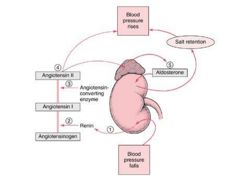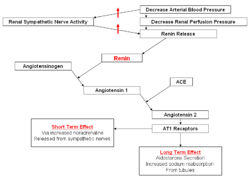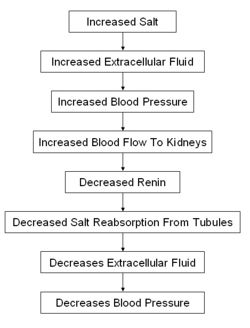Renin Angiotensin Aldosterone System
Also known as: RAAS
- Allows an animal’s salt intake to vary without any great affect on ECF volume or arterial pressure
- If an animal’s salts intake increased 50x its blood pressure would only increase 5-6mmHg
- Without the RAAS it would go up 10x that amount
The System
In the event of blood pressure dropping Renin is secreted due to the decreased stretch of the juxtaglomerular cells and an increased sympathetic stimulation triggered by the decreased activation of arterial baroreceptors. This enzyme cleaves the alpha glycoprotein Angiotensinogen which is released from the liver. This produces Angiotensin 1 which is further converted by Angiotensin Converting Enzyme (ACE) to Angiotensin 2 mainly in the lungs but to a much lesser extent locally in the kidneys. Angiotensin 2 then works to restore blood pressure. In this section we cover its effects on and through the kidneys.
Effects of Angiotensin 2 on Blood Pressure
Angiotensin 2 acts on AT1 receptors to stimulate the release of Aldosterone from the Zona Glomerulosa of the adrenal glands. This mineralocorticoid increases the reabsorption of sodium and therefore water and chloride from the distal tubule thus helping to increase blood volume and pressure. It also stimulates the thirst center and increases the secretion of ADH to help increase blood volume. Thanks to the RAAS pressure can return to 50% baseline within 15 minutes of haemorrhage.
Effects of Angiotensin 2 on GFR
If blood pressure drops then GFR also drops due to a reduced blood flow through the kidneys. Therefore it is important to prevent this. If contraction of the efferent arteriole occurs then the pressure difference between the afferent and efferent arterioles increases creating a greater filtration pressure. This effect is mediated by Angiotensin 2 and means that when blood pressure falls there is minimum alteration of GFR. Blood flow which is already reduced due to the reduced pressure will then be further reduced by the increase in resistance. This increased renal resistance to blood flow and the maintained GFR has many advantageous effects.
Advantages of Constriction of the Efferent Arteriole
- If you increase the resistance in the kidneys you contribute to increasing total peripheral resistance. This helps to return blood pressure towards normal. (Angiotensin 2 also has vasoconstrictive effects in other organs.)
- The kidneys can tolerate the reduced perfusion allowing blood to be prioritised to organs which need it like the brain and heart.
- The constriction of the efferent arterioles also reduces hydrostatic pressure in the Peritubular Capillaries this increases reabsorption of water and salt thus helping to restore the ECF and thus helps to normalise blood pressure.
- The amount of waste excreted is variable with GFR. Thanks to the normalised GFR the excretion of waste products such as urea is maintained.
Effects of Angiotensin 2 On Sodium
- Induces insertion of Na+ channels into renal tubules via stimulation of AT1 receptors
- Proximal tubule:
- Apical - Na+/H+ exchangers
- Basolateral Na+(HCO3-)3 and Na+K+ATPase
- Thick ascending limb
- Apical Na+/H+ exchangers and Na+K+2Cl- symporter
- Collecting Duct
- Epithelial Na+ channel
- Also stimulates Aldosterone
Revision
Use the flash card revision resource for this section to test yourself.


